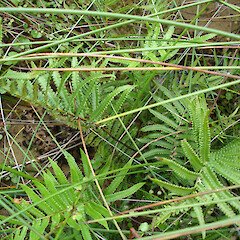Cyclosorus interruptus
Synonyms
Many including Pteris interrupta Willd., Thelypteris interrupta (Willd.) Iwatsuki, Nephrodium propinquum R.Br., Nephrodium inaequilaterum Colenso, Nephrodium unitum R.Br., Cyclosorus gongyloides (Schkuhr) Link; Dryopteris gongylodes var. glabra (Mett.) Domin; Dryopteris gongylodes sensu Cheeseman
Family
Thelypteridaceae
Flora category
Vascular – Native
Endemic taxon
No
Endemic genus
No
Endemic family
No
Structural class
Ferns
NVS code
The National Vegetation Survey (NVS) Databank is a physical archive and electronic databank containing records of over 94,000 vegetation survey plots - including data from over 19,000 permanent plots. NVS maintains a standard set of species code abbreviations that correspond to standard scientific plant names from the Ngä Tipu o Aotearoa - New Zealand Plants database.
CYCINT
Chromosome number
2n = 72
Current conservation status
The conservation status of all known New Zealand vascular plant taxa at the rank of species and below were reassessed in 2017 using the New Zealand Threat Classification System (NZTCS) – more information about this can be found on the NZTCS website. This report includes a statistical summary and brief notes on changes since 2012 and replaces all previous NZTCS lists for vascular plants.
Please note, threat classifications are often suggested by authors when publications fall between NZTCS assessment periods – an interim threat classification status has not been assessed by the NZTCS panel.
- Conservation status of New Zealand indigenous vascular plants, 2017 . 2018. Peter J. de Lange, Jeremy R. Rolfe, John W. Barkla, Shannel P. Courtney, Paul D. Champion, Leon R. Perrie, Sarah M. Beadel, Kerry A. Ford, Ilse Breitwieser, Ines Schönberger, Rowan Hindmarsh-Walls, Peter B. Heenan and Kate Ladley. Department of Conservation. Source: NZTCS and licensed by DOC for reuse under the Creative Commons Attribution 4.0 International licence.
2017 | At Risk – Declining | Qualifiers: RR, SO
Previous conservation statuses
2012 | At Risk – Declining | Qualifiers: SO
2009 | At Risk – Declining | Qualifiers: SO
2004 | Gradual Decline
Distribution
Indigenous: New Zealand: North Island (Te Paki to Kawhia Harbour, the Bay of Plenty (including Mayor Island / Tuhua), the Rotorua Lakes to Taupo and near East Cape). Also known from Australia and throughout the tropical and warm-temperate Pacific where it is not threatened.
Habitat
A species of geothermal habitats, and frost-free, coastal and lowland wetlands, especially those dominated by raupo (Typha orientalis) and swamp millet grass (Isachne globosa).
Wetland plant indicator status rating
Information derived from the revised national wetland plant list prepared to assist councils in delineating and monitoring wetlands (Clarkson et al., 2021 Manaaki Whenua – Landcare Research Contract Report LC3975 for Hawke’s Bay Regional Council). The national plant list categorises plants by the extent to which they are found in wetlands and not ‘drylands’. The indicator status ratings are OBL (obligate wetland), FACW (facultative wetland), FAC (facultative), FACU (facultative upland), and UPL (obligate upland). If you have suggestions for the Wetland Indicator Status Rating, please contact: [Enable JavaScript to view protected content]
OBL: Obligate Wetland
Almost always is a hydrophyte, rarely in uplands (non-wetlands).
Detailed description
A creeping fern with harsh, hairless, olive-green fronds to 800 mm long. Frond stalks are slender, up to 600 mm long × 5 mm wide, almost black at the base but becoming brownish. Frond leaflets (pinnae) occur in 9–15 pairs, the basal pair are larger and sickle-shaped with each successive pair becoming shorter. The spores are found in closely packed sori distributed nearer the midrib than the leaflet edge.
Similar taxa
Could only be confused with Pakau pennigera with which it sometimes grows. However, this species has longer, narrower pale green, soft hairy fronds of even length and shape that wilt easily. Pakau pennigera also occupies different habitats, being found on stream-banks in kahikatea remnants, and on shaded limestone overhangs and cave entrances.
Flowering
Spore bearing fronds may be found throughout the year
Flower colours
No flowers
Fruiting
Spore bearing fronds may be found throughout the year
Life cycle
Minute spores are wind dispersed (Thorsen et al., 2009).
Propagation technique
Easily grown from division of whole plants. Can be grown from fresh spore. Frost tender, and does best in damp or waterlogged ground.
Threats
Drainage, land development and fern collectors.
Etymology
interruptus: Interrupted in some way
Where To Buy
Sold by a few specialist native plant nurseries. Not widely grown.
Attribution
Fact sheet prepared by P.J. de Lange for NZPCN (1 June 2013)
References and further reading
Thorsen MJ, Dickinson KJM, Seddon PJ. 2009. Seed dispersal systems in the New Zealand flora. Perspectives in Plant Ecology, Evolution and Systematics 11: 285–309. https://doi.org/10.1016/j.ppees.2009.06.001.
NZPCN Fact Sheet citation
Please cite as: de Lange, P.J. (Year at time of access): Cyclosorus interruptus Fact Sheet (content continuously updated). New Zealand Plant Conservation Network. https://www.nzpcn.org.nz/flora/species/cyclosorus-interruptus/ (Date website was queried)








